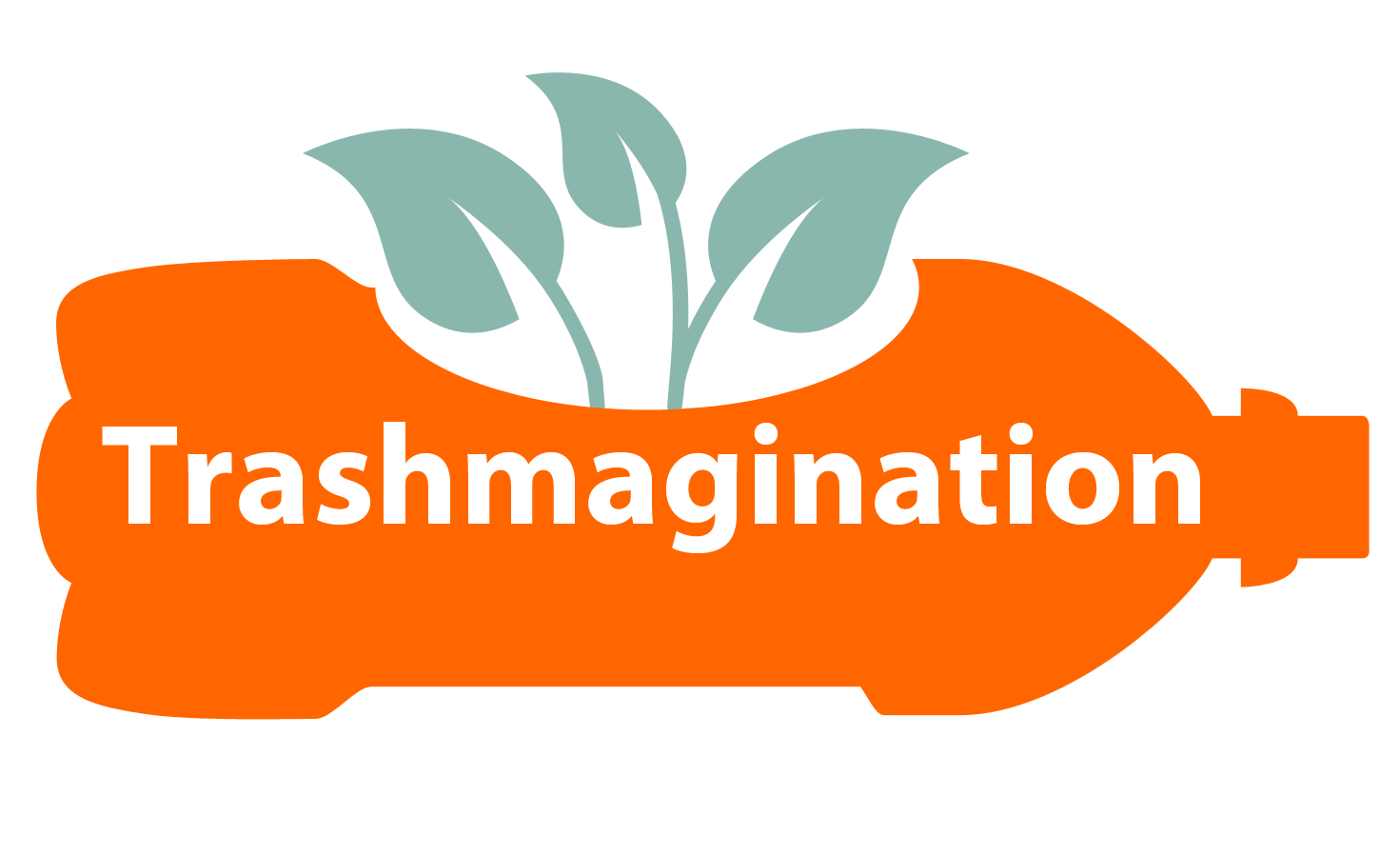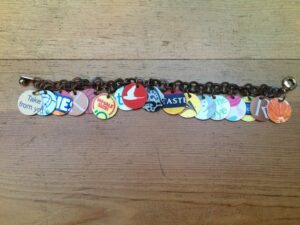Would you like to attract people to your town to enjoy nature and art? Organize a recycled art sculpture trail. Instead of hosting an arts festival in one area, people experience art along a trail – maybe in a downtown area or along a hiking trail. Maybe hearing about these trails, you will be inspired to make one in your area.
You can listen to my podcast episode on recycled art sculpture trails in this YouTube video. It originally aired in July 2019.
One interesting point about hosting a recycled art sculpture trail is that you need to protect the work from weather and vandalism. The sculptures have to be designed to be strong enough to last. Here are five ways these events tackle this:
- They host the trail in busy places – spots with heavy foot traffic even at night – so someone is always able to keep an eye on the sculptures.
- They host the trail in parks, botanicals gardens or on museum grounds where the gates can be closed at night.
- They build sculptures that would be difficult to damage, such as those built from wood or welded metal.
- They make sculptures that can be moved inside at night.
- They offer the trail only a very short time like one or two days.
Recycled Art Sculpture Trails
Trails and Vistas (Lake Tahoe, Nevada, USA)
Guided hikes take place over two days in September. All along the trails there are artists creating magical moments – musicians, dancers, people wearing incredible costumes as well as visual art pieces. In 2019, it’s happening on September 6 and 7. They also do a huge concert and a field trip program for third graders called Dreaming Tree. This event is not focused on recycled art sculptures but I wanted to mention it because it was the first time I heard about showing art on a trail, and many of their past costumes were made from recycled materials.
Sculpture by the Sea (Bondi & Cottesloe Beaches, Australia)
It is the world’s largest free public sculpture exhibition and it has been happening since 1997. It takes place in two parts of Australia currently. Each October and November, it is at Bondi Beach near Sydney. Then in March, it is in Cottosloe near Perth in Western Australia.
Most of the sculptures are not made from recycled materials, but here are my favorites made from recycled materials.
Georgina Humphries, Groundswell – made from tents collected at festivals, then sewn a series of pyramid shapes, all attached together.
Kerrie Argent, Over-Consumption – 5 sculptures from plastic caps all connected with zip ties, representing the gyres in the ocean where currents have swept huge amounts of plastic trash. She also made a sculpture called Homeless from recycled textiles that looked like a series of five patchwork tents.
I love their Tactile Tours for people with visual impairments or other challenges who would benefit from touching the sculptures.
Teignmouth Recycled Art in the Landscape or TRAIL (South Devon, UK)
This event has been happening for 15 years in South Devon. The sculptures are on a trail along a sea front. The trail is open from July 27 to September 1 and there are gallery exhibits. The trail incorporates visual art, performance pieces and fashion and the whole event ends in an arts festival. This year they made a giant fish out of discarded fishing rods, an old swing set and chicken wire called Rodney Gobblet. People put single-use plastic bottles inside his mouth to be recycled. You can vote for your favorite TRAIL sculptures online.
Aglow by Aurora Robson (Philadelphia, PA, USA)
The first is by one of my absolute favorite plastic creative reuse artists, Aurora Robson. She is Canadian-American like me! Her sculptures involve taking plastic trash and shaping it into abstract shapes. This summer until August 24, she has an exhibit called at the Schuykill Center for Environmental Education near Philadelphia, PA. These sculptures light up at dusk.
Birds on Broadway (New York City, NY, USA)
In New York City, there is an exhibit by Nicolas Holiber that opened in May 2019 and will continue until January 2020. This trail is presented in partnership with the NYC Department of Parks and Recreation and NYC Audubon. It features ten huge wooden sculptures of birds. These bird species all live in New York City or fly through it on their migratory routes, and they are all impacted by climate change. He built them from reclaimed wood from shipping pallets found around New York City. They are all located along Broadway starting at 64th Street all the way to 157th Street. That is a five-mile walk.
Thomas Dambo (Copenhagen, Denmark; Chicago, USA; Mexico City, Mexico and MORE)
Thomas builds huge wooden sculptures all over the world from reclaimed lumber. Two of his sculpture trails are in his home country of Denmark or at the Morton Arboretum in Chicago. In both places, he built a series of sculptures hidden in the vegetation and rocks, and you can search for them.
The trolls in Denmark are called the Six Forgotten Giants [https://thomasdambo.com/works/forgotten-giants/].
Besides building trails with giants and trolls, Thomas has also built a garden in Mexico City from plastic flowers and creatures called The Future Forest.
Patrick Amiot & Brigitte Laurent (Sebastapol, CA, USA)
Another recycled art sculpture artist with a big sense of humor is Patrick Amiot. He’s another Canadian who moved to the United States just like myself and Aurora Robson. Patrick and his wife Brigitte Laurent make very large metal sculptures in Sebastapol which is in northern California. My favorites are the ones that were clearly influenced by Patrick’s Canadian heritage such as the Mounties and the Toronto Maple Leafs goalie. In 2001, Patrick put his first giant sculpture on his front lawn. He knew it was likely someone would come and tell him to remove it. But instead his neighbors loved it, and since then, he has made a series of huge sculptures for each of his neighbors’ lawns. Now their street has become a tourist attraction. For three blocks on Florence Avenue, people can see the many hilarious recycled art sculptures made from all kinds of metal including car parts, pots, irons, giant metal cans and more. Patrick builds the sculptures and Brigitte paints them.
Washed Ashore (Many locations around North America)
The most impressive recycled art sculpture trail I have ever visited in person is called Washed Ashore. These are very large sculptures of ocean wildlife all made from trash that washed up on beaches. I first talked about this work in episode 42 which was about Beach Trash. The artist behind this trail is Angela Haseltine Pozzi. The pieces have traveled all over.
Creating Equilibrium Exhibit (Lake Tahoe, NV, USA)
Gilles Cenazondotti also makes wildlife sculptures with plastic he finds at the beach. In 2017, his work was displayed in an area near Lake Tahoe on a recycled art sculpture trail as part of an environmental festival called Creating Equilibrium. To make his sculptures, he first sculpts a piece of polyurethane foam and then covers it with plastic pieces found on the beach.
Remarkable Recycling Gala (Beeston, Nottingham, UK)
Michelle Reader makes animal sculptures from plastic. According to her website, the sculptures are now featured at local sites such as the Marwell Zoo.
Recycled Sculpture Trail (Paisley, Renfrewshire, Scotland)
In the town of Paisley in Scotland, there is an animal-themed sculpture trail built by Kevin Cantwell. Paisley is located west of Glasgow. It looks like most of his sculptures are made from recycled tires, including a panda, a bumblebee on a thistle and a ladybug.
Catskill Interpretive Center (Mt. Tremper, NY, USA)
The last recycled art sculpture trail includes a hilarious sculpture by Adrian Landon of a dung beetle pushing a giant sphere of trash. In the sphere there are plastic shopping carts and lots of other trash. Adrian said the sculpture was about how this sculpture represents “humanity’s need to recycle.”



